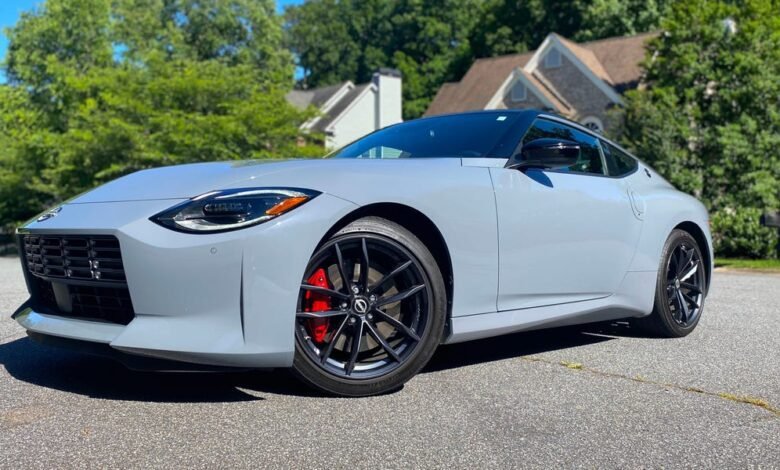Nissan Z review: Iconic sports car with high-tech engine and 6-speed

- The Nissan Z is the latest in a long line of iconic sports cars dating back more than 50 years.
- I liked the 2024 Nissan Z’s twin-turbocharged V6, 6-speed manual transmission and retro look.
- I was disappointed by the Z’s unsatisfactory engine sound and poor backup camera.
Every brand needs a halo product – a car that reminds customers and employees of its origins, values and goals.
He embodies the soul of that company.
Ford has the Mustang, Mercedes the S-Class and Porsche the 911.
For Nissan, with the GT-R supercar set to retire after 17 years in service, that job will be left to the Fairlady Z, known in the United States simply as the Z.
The current Nissan Z was launched in 2023 with more power and technology than the 370Z managed.
I recently spent a week driving a 2024 Nissan Z Performance through the streets of Atlanta and the winding roads of the Appalachian foothills.
I loved its powerful 3.0-liter twin-turbo V6 and 6-speed manual transmission. I was also impressed with the level of technical content and overall fit and finish.
There wasn’t much to complain about, but I felt a little let down by the unsatisfactory engine noise and one of the worst quality backup cameras I’ve ever encountered.
My Nissan Z Performance test car costs $55,110.
The base Nissan Z Sport starts at $42,970, while the top-of-the-line and more powerful Z NISMO starts at $65,750.
My mid-level Performance trim with manual transmission starts at $52,210. Freight fees and optional extras raised the as-tested price to more than $55,000.
The history of the Z in the US dates back to 1970, when the S30 Fairlady Z went on sale as the Datsun 240Z.
The iconic 240Z has become synonymous with stylish performance at an affordable price. Over the years there have been a number of memorable Nissan Z-Cars, including the all-conquering Z32 300ZX Twin-Turbo, which hunted supercars for the sport in the early 1990s, and the more recent 370Z NISMO Tech.
The Z-Car’s long hood and sloping rear are signature elements of the Z-Car’s classic look.
Nissan’s design team, led by Cuban-American chief designer Alfonso Albaisa, left no doubt as to this car’s pedigree. Take one look at its silhouette and you’ll know it’s a Z.
The Z’s angular front fascia and slightly recessed LED headlights also nod to the 240Z.
It’s a look that debuted on the Z Proto concept car in fall 2020.
At the rear, the sloping roofline merges with the decklid spoiler.
Aesthetically, the Nissan Z is a perfect blend of modernity and retro Z-car style.
The styling may be new, but the new Z is built on an updated version of Nissan’s venerable FM platform, which also underpins the 370Z and Infiniti’s Q50 sedan and Q60 Coupe.
My test car came with dark gray 19-inch RAYS forged aluminum alloy wheels.
Behind the alloy wheels, Nissan Zs in Performance trim get 14-inch four-piston ventilated disc brakes at the front and 2-piston discs at the rear.
One of the Z’s standout features is a 6-speed manual transmission.
The manual is carried over from the 370Z, but the 6-speed has been updated with beefier synchronizers to facilitate better shifts. And that’s exactly what I discovered. The changes were sharp and fast.
The manual comes standard on Sport and Performance versions, with the automatic also available as a no-cost option.
Unlike previous iterations, this Z has electric power steering instead of the traditional hydraulic system.
The transition to electronic power steering, which often dulls steering feel and wheel feedback, hasn’t diminished the Z’s handling prowess. I found the steering to be smoother than the last 370Z I drove.
The move also allows Nissan to incorporate semi-autonomous driving and driver assistance features.
The Nissan Z features intelligent cruise control, automatic emergency braking, predictive forward collision warning, blind spot warning, land departure warning and rear cross traffic alert.
The Z is powered by a twin-turbo V6 engine.
All Nissan Z variants are powered by a 3.0-liter twin-turbo VR30DDTT V6 engine, which sends power to the rear wheels via a 6-speed manual or 9-speed automatic transmission.
The VR30 produces a robust 400 horsepower and 350 lb-ft of torque in Sport and Performance trims. The NISMO edition gets an extra 20 horsepower and 34 lb-ft of torque.
The VR30 is also a descendant of the hand-built VR38DETT engines found under the hood of the GT-R supercar.
Fuel economy probably isn’t the priority for most sports car buyers, but for those interested, Nissan Zs (in Sport and Performance trims) with the 6-speed boast fuel economy numbers of 18 mpg city, 24 mpg on the highway and 20 mpg combined. Choose the automatic (please don’t), and fuel economy numbers improve to 19 mpg in the city, 28 mpg on the highway and 22 mpg in combined driving.
The Nissan Z was an absolute blast to drive.
Nissan has really delivered in terms of driving.
On a winding road, the Bridgestone Potenza car took turns with the confidence expected from a world-class sports car.
Although it’s heavier than its predecessors, the 350Z and 370Z, it felt much lighter and more balanced.
The Zs I’ve driven in the past have felt more like powerful Japanese muscle cars than true sports cars. They were monsters in a straight line, but felt heavy and unsafe in the corners.
They also provided a surprisingly comfortable ride, easily soaking up rough roads and small potholes, which is unusual for a car with low-profile tires and a sport-tuned suspension.
Although it now has a quicker foot in the corners, it hasn’t lost any straight-line performance.
The Z’s VR30 engine roars off the line like a furious draft horse, without a hint of turbo lag, quickly bringing 3,500 vehicles to highway speeds.
The twin-turbo V6 has a torque curve that peaks at 350 lb-ft at just 1,600 revs and remains available until 5,600 rpm. Paired with a launch control system that allows you to shift gears without lifting the throttle, accelerating in the Z results in smooth, uninterrupted power and acceleration.
According to Motor Trend, the Nissan Z Performance with manual transmission can go from 0 to 60 mph in just 4.9 seconds.
Unfortunately for us sports car purists, that time will probably be a little quicker with the automatic.
My only real complaint with the driving experience was the engine’s unsatisfactory sound, which lacked the sharp crescendo of a high-revving four-cylinder or the low growl of a V8. It just seemed like a dull, listless drone.
Inside, the Z’s cabin is cozy, with room for two people.
Like a sports car, the front dashboard and center console are angled to make it easier for the person in the driver’s seat to use. The fit and finish of the interior was solid, although I didn’t mind the bright blue seats and trim pieces.
At the top of the dash is a set of three analog gauges.
The gauges, which are reminiscent of the original 240Z, show voltage, boost pressure and turbo rpm.
In front of the driver is a Z-branded steering wheel and a large 12.3-inch digital instrument display.
The display is customizable with three different layouts that suit a variety of driving situations, from everyday use to high-performance driving.
The Z is equipped with a 9-inch touchscreen infotainment display.
It runs Nissan’s corporate infotainment interface, which is quite intuitive to use. It’s also equipped with wireless Android Auto and Apple CarPlay.
While the screen quality is excellent, the backup camera image quality was not.
The backup camera images were blurry and faded. It’s one of the worst cameras I’ve come across.
Hidden under the infotainment screen are the climate control buttons.
The dials themselves are easy to use, but their location lower on the center console made adjusting the temperature while driving more cumbersome than necessary.
The hideous blue leather and faux suede seats were well padded and supportive.
The Z Seat’s power controls are located in an awkward spot between the seat and the center console. It’s a carryover from the 370Z.
Behind the passenger cabin is a large but shallow cargo area.
There’s room under the cargo area for a spare tire, but that area was taken up by the subwoofer of the Z’s 8-speaker Bose stereo.
You access the cargo area by opening the large rear door.
The button to open the hatch is located at the bottom of the Nissan logo.
My verdict: it’s impossible not to like the Nissan Z.
With the new Z, Nissan has given us a modern take on the sports car that has helped cement the company’s position in America for more than five decades.
And man, what a sports car they gave us.
It looks great, is agile and confident in corners, has one of the best V6 engines money can buy, and most importantly, it has a smooth-shifting manual transmission.
The Nissan Z is one of the last of a dying breed.
In an era of 1,000-horsepower electric vehicles with semi-autonomous driving, the market for gasoline-powered sports cars with manual transmissions is growing smaller and smaller.
If you get the chance, buy it while it’s still here. Or you might regret it later.



